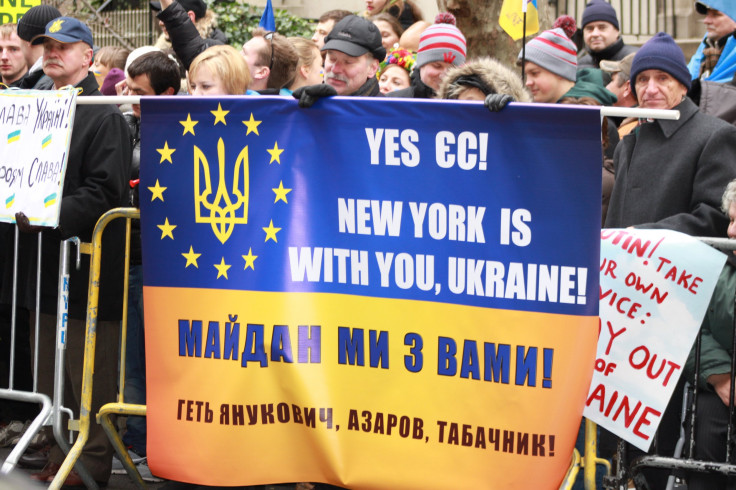EuroMaidan Protests In NYC: Supporters Across US Cheer For Ukraine’s Integration Into EU
Supporting Ukraine

Clad in blue and yellow, and draped in Ukrainian flags, nearly a thousand protesters flanked 49th Street in New York City on Sunday afternoon, filling up Second and Third avenues outside the Consulate General of Ukraine to voice their support for “EuroMaidan,” a movement that aims to oust President Viktor Yanukovych from power and bring Ukraine into the European Union.
As crowds in Ukraine's capital city of Kiev grew -- swelling up to one million Sunday -- supporters of the country's integration into the European Union, or EU, have also risen across the U.S. The movement, which has been called a revolution by some, began on Nov. 21 after Yanukovych decided at the last minute to cancel a trade deal with the EU to solidify economic ties more closely with Russia instead, helping EuroMaidan become the largest demonstration in Ukraine since the 2004 Orange Revolution.
In New York, a mix of Ukrainian and American protesters shouted slogans in both their native language and English -- “Russian hands off Ukraine! Yanukovych is not a Ukrainian president!” -- and held up signs that read, “Impeach [the] criminal government in Ukraine,” and “Yanukovych: back off!” The protesters started out with a prayer, “Our Father” in Ukrainian, then sang the Ukrainian national hymn, as well as several other popular Ukrainian songs, throughout the protest.
“New York City is an important and symbolic place for Ukrainians to speak out,” Oksana Lytvyn, a pharmacy student who is part of The Federation of Ukrainian Student Organizations of America, or SUSTA, said at the protest. Speaking of SUSTA's members, she said: “We grew up in the USSR…but we understand that things in Ukraine should be changed, and we are ready to do something about it.”
On The Streets Of Kiev
Earlier on Sunday, protesters in Kiev built barricades to block important government buildings. A group also tore down a statue of Lenin in the center of the city, a symbolic but controversial action. This action prompted speakers at the protest in New York to rally the crowd, saying: “If Lenin couldn’t withstand EuroMaidan, what do you think will happen to Yanukovych and [Ukrainian Prime Minister Mykola] Azarov?”
Although the movement has, for the most part, attempted to maintain a peaceful front, last week, angry protesters spurred a backlash from Ukraine's government and local police, who beat several aggressive protestors in addition to peaceful bystanders and journalists. More than 260 people have so far been injured. Western powers, meanwhile, have urged both the Ukrainian government and the opposition to abstain from further violence.
Yanukovych hasn’t shown any signs of compromising with the protestors, and instead has been holding talks with Russian President Vladimir Putin to negotiate a “strategic partnership” to help Ukraine meet $17 billion in debt repayments and Russian gas bills. The deal with Russia would provide Ukraine with cheaper Russian gas.
Vitali Klitschko, world boxing champion and a leading voice for the EuroMaidan movement, told reporters in Kiev Sunday that he is “convinced that after these events, dictatorship will never survive in our country. People will not tolerate when they are beaten, when their mouths are shut, when their principles and values are ignored.”
Kiev was the scene of the Orange Revolution in 2004, when Ukrainians rose up to support European-minded presidential candidate, Viktor Yushchenko, against Russia-influenced Yanukovych.
But EuroMaidan is slightly different, mostly because it “isn’t politically party-oriented,” according to Andrij Dobriansky, a Ukrainian community organizer based in New York.
“One of the things that benefits this movement is that there is no unified opposition. There’s no party taking over – it can really be a national movement. I’ve got to say, it’s [similar to] Occupy [Wall Street],” Dobriansky said.
While Occupy Wall Street may have failed because the movement lacked a goal, EuroMaidan’s objective is clear-cut: Ukrainians simply want to join the EU.
And, though Ukraine's entry into the EU might not be an overnight success story and it could take several years before the country can become economically and politically stable, it is “the way to move forward,” Dobriansky said.
Supporting Ukraine
Meanwhile, those protesting at the Consulate General of Ukraine in New York were focused on maintaining a peaceful image of the EuroMaidan movement, and showed their gratitude to the NYPD for allowing them to demonstrate, and said several prayers for peace.
“It’s necessary to support all the people in Ukraine who are demonstrating,” Xenia Iwasykiw, a protestor originally from New York City who has family in Ukraine, told International Business Times. “[Ukrainians] feel like they are European. They want to integrate into the European community, and they are being stopped by their own government.”
Iwasykiw said her relatives, currently protesting on the streets of Kiev and Lviv, are uplifted by the solidarity they see from their supporters in American cities and around the world. Some protesters even held up their phones, showing they were in real-time contact with their families back in Ukraine using social networking tools such as Skype and FaceTime. Demonstrations were also held in Philadelphia, Chicago, Cleveland and San Francisco.
“This originally started with Ukraine wanting to be a part of Europe, but it’s grown into so much more than that in the past couple of days,” Khrystyna Chorniy, a 23-year-old nurse originally from Ukraine who is now working in New Jersey, told IBTimes. “Because now….the government needs to leave because the people are suffering from its decisions.”
© Copyright IBTimes 2024. All rights reserved.





















